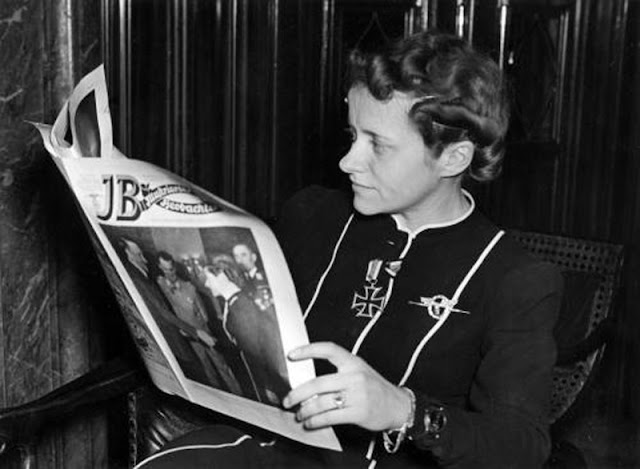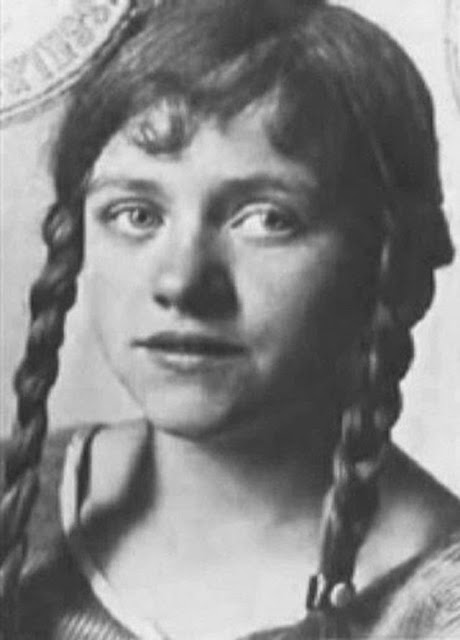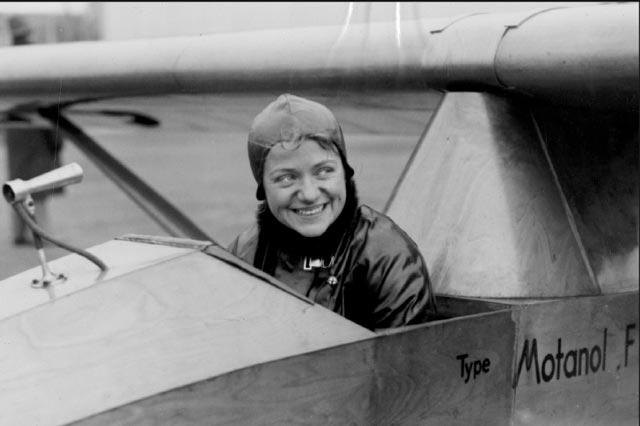The Eternal Aviator
Whether you take inspiration from such figures is your affair, and easy if you can separate out the laudable qualities from the political associations that you don't personally like. This article is intended for those who want to learn about a true giant of aviation, albeit an extremely controversial one: Hanna Reitsch, a woman who blazed a trail of glory and heartbreak for those interested in true female pioneers who achieve because of what they do and not who they are.
 |
| Hanna Reitsch on 27 August 1938 (Heinrich von der Becke, Federal Archive). |
Pre-War Year
Hannah Reitsch was born in Hirschberg, Silesia in the German Empire (Jelenia Góra in modern Poland) on 29 March 1912. While a pre-med student in Berlin, she became interested in flying and signed up for flying lessons at the German Air Mail amateur flying school in 1932.She showed such promise that the following year she quit school early and became a full-time glider pilot and instructor in the town of Hornberg in Baden-Württemberg (southwest Germany). It was the right time to begin a flying career, because the new Chancellor of Germany, Adolf Hitler, had plans for German aviation. Big plans.
 |
| Hanna Reitsch with aircraft designer Alexander Lippisch, center, and Willy Messerschmitt, right. |
Hanna, already qualified on powered planes, quickly began testing the limits of Luftwaffe aircraft. She became adept at performing aerobatics in a Focke-Wulf Fw 44 biplane, which impressed Ernst Udet, one of the world's top aerobatics pilots himself. Udet happened to be a World War I ace and friend to fellow ace Hermann Goering, as well as a top Luftwaffe General. He made Hanna the first Flight Captain in the world.
Through his position as head of the T-Amt (the development wing of the Reichsluftfahrtministerium) (Reich Air Ministry), Udet had Hanna posted to the Rechlin-Lärz Airfield development airfield north of Berlin in September 1937. Another reason for her rapid advancement was the fact that she was a fervent supporter of Hitler, fully committed to the regime and its development.
It was an amazing time to be a German test pilot. Rechlin was ablaze with exotic aircraft that nobody had flown. Hitler was throwing huge resources into airplane development, and brilliant German designers such as Kurt Tank at Focke-Wulf had opportunities to expand the limits of aviation. Jet engines, helicopters, rockets - everything was going on at once, and the Luftwaffe needed brave and skilled pilots to try out its new and untested equipment. It was the most advanced aviation facility in the world. Hanna Reitsch stepped forward along with her friends from the glider days and took the risks.
Some view Hanna as a kind of feminist icon, but that was not her thing. She was candid about the fact that some men resented "this girl's" presence, but Hanna never portrayed herself as "breaking ceilings" or "being the first woman" in the fashion of a modern feminist. She never suggested that beating men or proving a point against them was her goal. In fact, throughout her life, Hanna respected strong men and gravitated to them. Hanna enjoyed her success, but she wasn't doing it "for women"; she was doing it to accomplish new things just like the men, to push the barriers of speed and performance.
Reitsch was "goal-oriented." This non-confrontational perspective might seem alien to feminists today, but it was part of the reason why Hanna succeeded and prospered. The only part of her attitude recognizable as "feminist" is that she became an idol and mentor to girls - imbuing them with the Hitler spirit and drawing them to the cause. That, however, was not her goal, just a byproduct of her own success. If she led, she led by example, not design.
In 1938, Professor Heinrich Focke of Focke-Wulf had a strange new craft that he wanted to show to the world. Designed by Focke himself along with engineer Gerd Achgelis, it was a huge leap forward from autogyros, a craft powered by two rotors capable of independent vertical flight. As the first of its kind, this "helicopter" - years ahead of Igor Sikorsky's first helicopter in the United States - was ready to be demonstrated to the world. Focke, knowing that the world press would ignore a demonstration at some remote German airfield, decided that he would force the press to take notice. He knew just how to do it.
You push this forward, and the craft does this, you step on this pedal and it does that - this was all the instruction Hanna had. Focke then invited in the world press, and Hanna flew the helicopter inside the stadium flawlessly - the first time anyone ever had done that. Hanna continued flying the craft (it had counter-rotating rotors, so required no tail rotor) nightly. For this, Hanna Reitsch received the Military Flying Medal.
World War II
Propaganda Minister Joseph Goebbels was always looking for propaganda heroes, and Hanna was a natural. She continued to demonstrate the Fw 61 for audiences, but also found time to set a record in the DFS Habicht sailplane in the Cleveland National Air Races. The Luftwaffe gave Hanna a Dornier Do 17 twin-engine bomber for her personal use, and she would fly around testing new aircraft and performing at different airports. Among the aircraft she tested were the Junkers Ju 87 Stuka dive-bomber, the DFS 230 glider for carrying troops (used at Belgian fortress Eben Emael), and a special Do 17 outfitted to cut barrage-balloon cables. |
| Hanna with a familiar face on the magazine's cover. |
Hanna's celebrity made her a valuable tool of the government. With the Wehrmacht reeling from the catastrophe at Stalingrad, Luftwaffe Colonel-General Ritter von Greim had her visit airfields on the Eastern Front in her personal Fieseler Storch plane to raise morale. However, Hanna remained a top test pilot, not just a propaganda hero, and this exposed her to a lot of danger. While visiting the Peenemünde Army Research Center on an island in the Baltic later in the year, Hanna was present when the RAF bombed it in Operation Hydra on the night of 17 August 1943. Hanna was sleeping in a nearby barracks not targeted by the bombers and claimed to have slept through the attack.
The war situation became desperate in 1944, and with great reluctance, some in the Luftwaffe began considering suicide planes for use against Allied bombers. Nobody was very enthusiastic about the project, including Hitler, but the bombers were destroying German cities with impunity and something had to be done. Hanna herself went to Hitler at Berchtesgaden on 28 February 1944 and proposed the idea, and she charmed him into approving it. However, they still had to settle on a plane to use.
 |
| A Me 328 pulse jet fitted with a bomber in a Mistel configuration. |
 |
| Hanna Reitsch posing with the manned V-1 cruise missile "Reichenberg." |
 |
| The Tiergarten (here in 1945/46) was converted into an emergency airstrip. (Foto: picture-alliance / Everett Colle). |
 |
| Hanna Reitsch was one of the very few females to earn the Iron Cross First Class, and she wore it with great pride. |
 |
| Hanna greeting some BDM girls. |
Hanna was captured with von Greim and other Reich leaders in northern Germany at the end of the war. The Allied interrogators were bemused by Hanna because German women generally did not become high profile figures in the Third Reich. An interrogator posed the question to her about what actually had happened during the trip to the Berlin bunker. She responded:
It was the blackest day when we could not die at our Führer's side.... We should all kneel down in reverence and prayer before the altar of the Fatherland.The astonished interrogator asked Hanna where the "altar of the Fatherland" was located. She replied:
Why, the Führer's bunker in BerlinThe Allied did not really know what to do with Hanna. She was an outspoken supporter of Hitler, but she was not accused of any war crimes and was not even a member of the military. After holding her for 18 months (for no reason), they released her. No charges.
Post-War
Life, of course, could never be the same for Hanna Reitsch. Her entire family, living in what was widely known to become part of the Soviet occupation zone (and soon to become part of Poland, which was not known), was convinced that they would not be allowed to remain there (which was accurate). They committed suicide after fleeing to western Germany (Hanna's father shot her mother, sister, and her sister's three children, then himself). Just like after World War I, German civilians were forbidden from flying powered aircraft, but gliding soon became permissible again. Returning to her original love, Hanna Reitsch began entering glider competitions. She set numerous glider records and in large part rehabilitated herself, becoming the German Champion in 1955. She fascinated leaders around the world. Hanna met Indian Prime Minister Jawaharlal Nehru and established a glider school in New Delhi, then met President John F. Kennedy. After that, she moved to Africa, which was near Europe but far away in spirit at the same time.
 |
| Hanna with Kwame Nkrumah on the first anniversary of their flight school. From Reitsch, "I Fly for Kwame Nkrumah" (Munich: JF Lehmanns Verlag 1968) 35. |
 |
| Hanna Reitsch, perhaps around the time of the 1971 Helicopter World Championship. |
Hanna Reitsch's Last Days
Hanna was vigorous throughout the 1970s. She continued to set glider distance records and even returned to helicopter competitions. In 1971, she won the female class in the 1st Helicopter World Championships with co-pilot Doerli Schrimpf. In 1979, she set her last record, the Women Out & Return World Record (805 km) flown over the Appalachian Ridges. Her last flight over the Alps in June 1978 was later repeated in a vivid documentary that fully captured the glorious, soaring experience (see below). As she undoubtedly would have wished, the star is the experience and the glider, not Hanna - but she is the true creator.Hanna, however, now was a bitter woman. Her bitterness had nothing to do with herself, but rather with the state of Germany. Divided into two by the Allies, Germany, in Hanna's eyes, had lost its identity. In 1976, she gave a filmed interview to American photojournalist Ron Laytner. It provided a detailed summary of her experiences during World War II, but the most astonishing aspect was her unrepentant devotion to the Third Reich:
And what have we now in Germany? A land of bankers and car-makers. Even our great army has gone soft. Soldiers wear beards and question orders. I am not ashamed to say I believed in National Socialism. I still wear the Iron Cross with diamonds Hitler gave me. But today in all Germany you can't find a single person who voted Adolf Hitler into power ... Many Germans feel guilty about the war. But they don't explain the real guilt we share – that we lost.Hanna Reitsch was described in press reports as being naive politically. For her, the main thing was more about Germany itself than the Third Reich, though many may not see the distinction in her case. In a word - a clumsy word, a too-general word - she was a patriot. Perhaps, for those who can't fathom her unrepentant attitude thirty years after the end of World War II, that will suffice as an explanation.
And now we come to the last act for Hanna Reitsch. Growing older, having recently set yet another world glider record, with a Germany headed in her view in the wrong direction, there was little left to live for. Hanna was found dead in her home in Frankfurt on 24 August 1979. There was no autopsy recorded and no big funeral. The coroner simply ascribed the cause of death to "heart attack," which could have been caused by anything.
Reitsch's friend former British test pilot Eric Brown, however, thought he knew the true story. He received an odd, brief letter from Hanna shortly before her passing in which she wrote:
With those reservations, one also can conclude that Hanna Reitsch was quite possibly the most outstanding female pilot in history, and one of the most daring, fearless, and accomplished pilots of either gender in all of aviation history. She let nothing get in the way of what needed to be done in the air, and did it right up until the day she died. She ventured into war zones, she took risky flights on deathtraps, and she did her duty as she saw it in legendary fashion. Hanna Reitsch may not be admired by all, but there is no question about one thing: she will be remembered for her role in history. And that, by itself, is a victory.
2021
It began in the bunker, there it shall end.Many agree with Brown's speculation that Hanna Reitsch ended her life in the only appropriate way for her: using the cyanide capsule given to her by the Führer in the Berlin bunker. That, Brown believed, fulfilled a suicide compact with Greim, who had upheld his end of that agreement on 24 May 1945.
Conclusion
Hanna Reitsch was unrepentant to her death and loyal to her death. There is no evidence that she ever had anything to do with war crimes, she never was charged with crimes, and the one time that she asked Heinrich Himmler about such, he denied it to her face. That said, Hanna served an abhorrent regime that repressed and killed people without mercy. Whether or not that makes her a terrible person and complicit in the crimes of the state is for you to say, as we each must draw our own conclusions. It is fair to say that her reputation will forever be tainted, and that is a tragedy for a woman with so many outstanding qualities.With those reservations, one also can conclude that Hanna Reitsch was quite possibly the most outstanding female pilot in history, and one of the most daring, fearless, and accomplished pilots of either gender in all of aviation history. She let nothing get in the way of what needed to be done in the air, and did it right up until the day she died. She ventured into war zones, she took risky flights on deathtraps, and she did her duty as she saw it in legendary fashion. Hanna Reitsch may not be admired by all, but there is no question about one thing: she will be remembered for her role in history. And that, by itself, is a victory.
2021

















Thank you once more for presenting yet another very interesting topic! I've just a little remark to make regarding the Fw 61: You state that it was an "unstable craft" due to the lack of a tail rotor. Well, it had two main rotors rotating in opposite directions, so there was absolutely no need for a tail rotor! Tail rotors are only needed to compensate the rotational forces that are inherent to single-rotor helicopters...
ReplyDeleteThank you, Ralph. I'm no expert on helicopters, but what you say makes 100% sense - the two rotors would counteract each others' torque. I have made the change and greatly appreciate expert insight such as yours that corrects my errors. James
Delete..."(used at Dutch fortress Eben Emael)"... should be Belgian :-))
ReplyDeleteThanks, when I'm sitting there typing away sometimes my mind goes blank. Many thanks!
DeleteThere is a lot more to this story.......This is only the arrival of Greim and Reitsch
ReplyDeleteWhat happened after their departure is also very mysterious
BTW it was important to the British government to prove Hitler dead to prevent the growth of a "Legend". Hence Trevor-Roper.....
Is it true that Hitler escaped to Indonesia and died there ?
ReplyDelete